Organisational Behavior: Enhancing Staff Motivation with Examples
VerifiedAdded on 2023/06/12
|7
|2491
|296
Essay
AI Summary
This essay delves into the critical role of motivation in enhancing employee performance within an organization. It explores various methods for improving staff motivation, emphasizing the creation of a positive work environment, continuous feedback, and public recognition. The essay differentiates between intrinsic and extrinsic motivation, providing examples relevant to housekeeping staff, such as non-monetary incentives and unannounced rewards. It further discusses Frederick Herzberg’s Two-Factor Theory, highlighting hygiene and motivational factors that influence job satisfaction. Ultimately, the essay concludes that motivation is essential for fostering willingness among employees to perform tasks effectively, and it advocates for a tailored approach that considers both the individual and the organizational context. Desklib provides solved assignments for students.
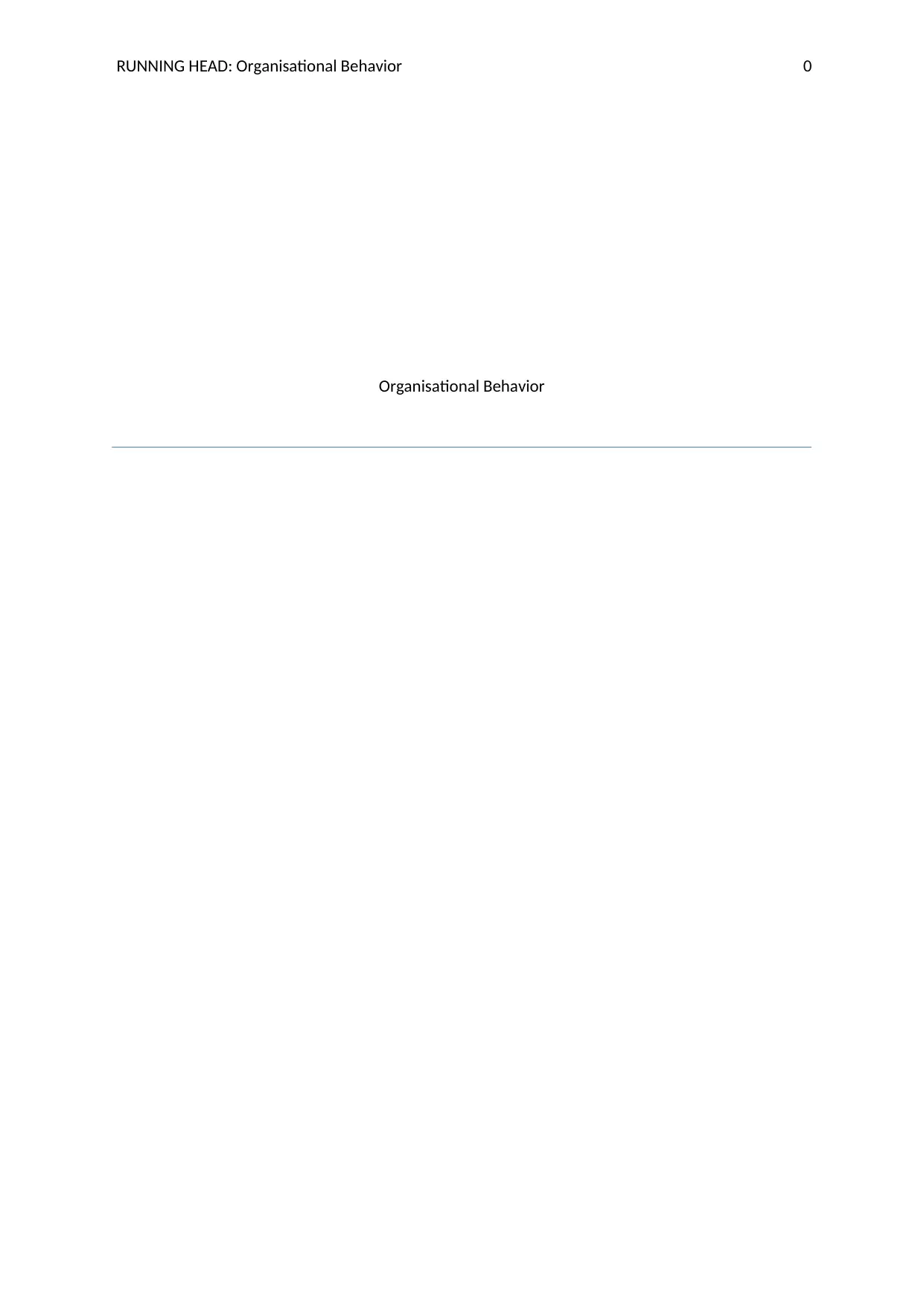
RUNNING HEAD: Organisational Behavior 0
Organisational Behavior
Organisational Behavior
Paraphrase This Document
Need a fresh take? Get an instant paraphrase of this document with our AI Paraphraser
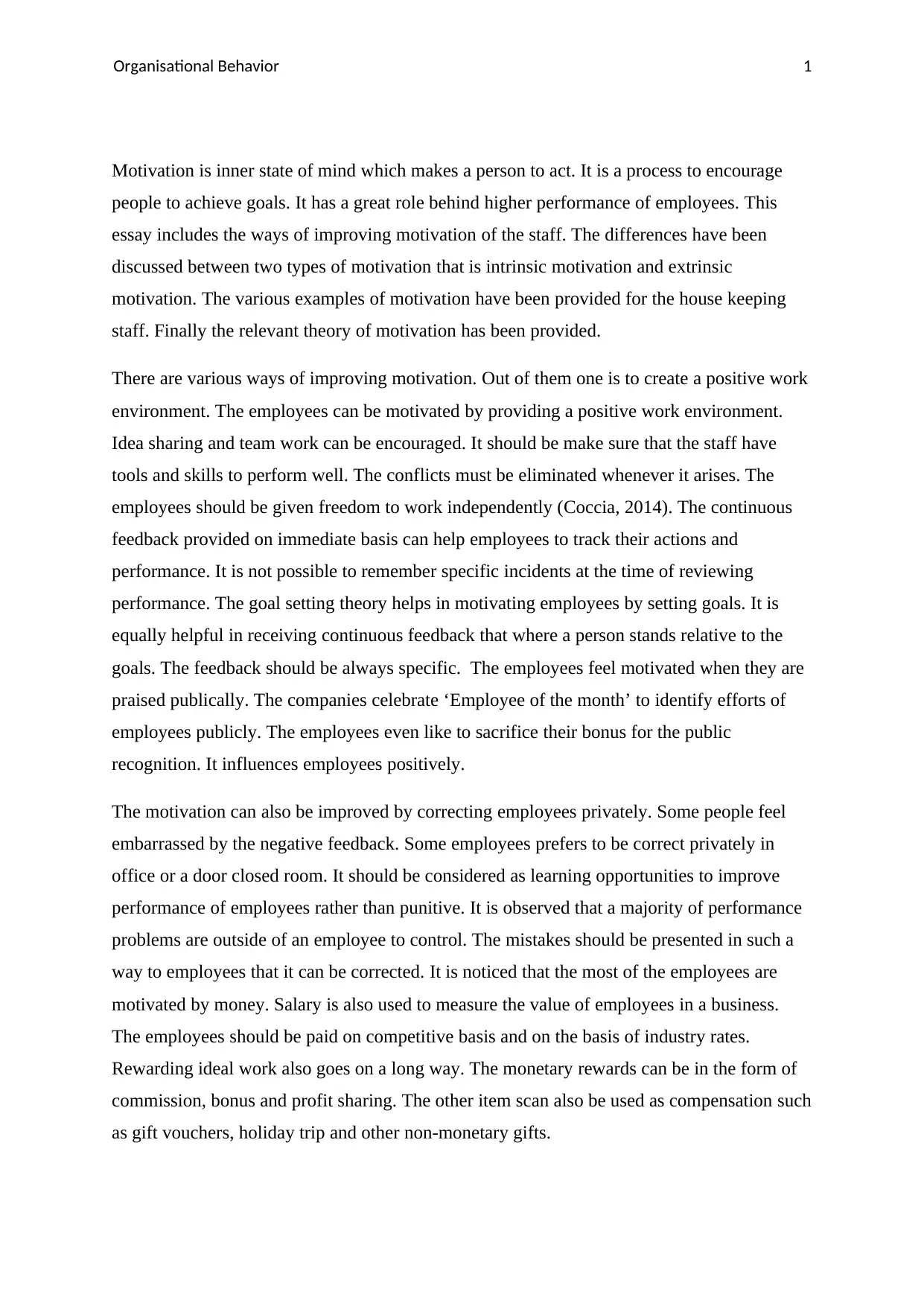
Organisational Behavior 1
Motivation is inner state of mind which makes a person to act. It is a process to encourage
people to achieve goals. It has a great role behind higher performance of employees. This
essay includes the ways of improving motivation of the staff. The differences have been
discussed between two types of motivation that is intrinsic motivation and extrinsic
motivation. The various examples of motivation have been provided for the house keeping
staff. Finally the relevant theory of motivation has been provided.
There are various ways of improving motivation. Out of them one is to create a positive work
environment. The employees can be motivated by providing a positive work environment.
Idea sharing and team work can be encouraged. It should be make sure that the staff have
tools and skills to perform well. The conflicts must be eliminated whenever it arises. The
employees should be given freedom to work independently (Coccia, 2014). The continuous
feedback provided on immediate basis can help employees to track their actions and
performance. It is not possible to remember specific incidents at the time of reviewing
performance. The goal setting theory helps in motivating employees by setting goals. It is
equally helpful in receiving continuous feedback that where a person stands relative to the
goals. The feedback should be always specific. The employees feel motivated when they are
praised publically. The companies celebrate ‘Employee of the month’ to identify efforts of
employees publicly. The employees even like to sacrifice their bonus for the public
recognition. It influences employees positively.
The motivation can also be improved by correcting employees privately. Some people feel
embarrassed by the negative feedback. Some employees prefers to be correct privately in
office or a door closed room. It should be considered as learning opportunities to improve
performance of employees rather than punitive. It is observed that a majority of performance
problems are outside of an employee to control. The mistakes should be presented in such a
way to employees that it can be corrected. It is noticed that the most of the employees are
motivated by money. Salary is also used to measure the value of employees in a business.
The employees should be paid on competitive basis and on the basis of industry rates.
Rewarding ideal work also goes on a long way. The monetary rewards can be in the form of
commission, bonus and profit sharing. The other item scan also be used as compensation such
as gift vouchers, holiday trip and other non-monetary gifts.
Motivation is inner state of mind which makes a person to act. It is a process to encourage
people to achieve goals. It has a great role behind higher performance of employees. This
essay includes the ways of improving motivation of the staff. The differences have been
discussed between two types of motivation that is intrinsic motivation and extrinsic
motivation. The various examples of motivation have been provided for the house keeping
staff. Finally the relevant theory of motivation has been provided.
There are various ways of improving motivation. Out of them one is to create a positive work
environment. The employees can be motivated by providing a positive work environment.
Idea sharing and team work can be encouraged. It should be make sure that the staff have
tools and skills to perform well. The conflicts must be eliminated whenever it arises. The
employees should be given freedom to work independently (Coccia, 2014). The continuous
feedback provided on immediate basis can help employees to track their actions and
performance. It is not possible to remember specific incidents at the time of reviewing
performance. The goal setting theory helps in motivating employees by setting goals. It is
equally helpful in receiving continuous feedback that where a person stands relative to the
goals. The feedback should be always specific. The employees feel motivated when they are
praised publically. The companies celebrate ‘Employee of the month’ to identify efforts of
employees publicly. The employees even like to sacrifice their bonus for the public
recognition. It influences employees positively.
The motivation can also be improved by correcting employees privately. Some people feel
embarrassed by the negative feedback. Some employees prefers to be correct privately in
office or a door closed room. It should be considered as learning opportunities to improve
performance of employees rather than punitive. It is observed that a majority of performance
problems are outside of an employee to control. The mistakes should be presented in such a
way to employees that it can be corrected. It is noticed that the most of the employees are
motivated by money. Salary is also used to measure the value of employees in a business.
The employees should be paid on competitive basis and on the basis of industry rates.
Rewarding ideal work also goes on a long way. The monetary rewards can be in the form of
commission, bonus and profit sharing. The other item scan also be used as compensation such
as gift vouchers, holiday trip and other non-monetary gifts.
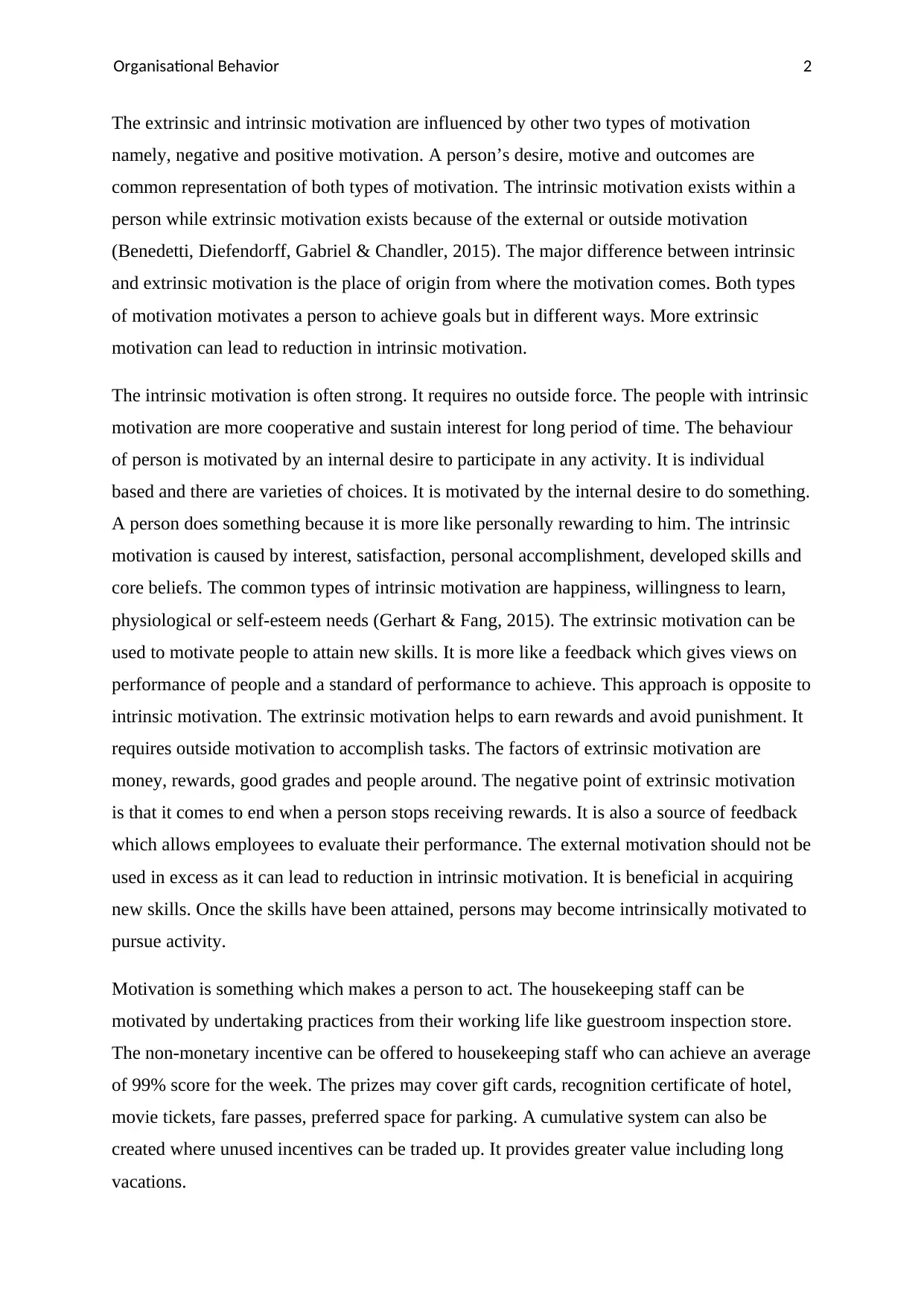
Organisational Behavior 2
The extrinsic and intrinsic motivation are influenced by other two types of motivation
namely, negative and positive motivation. A person’s desire, motive and outcomes are
common representation of both types of motivation. The intrinsic motivation exists within a
person while extrinsic motivation exists because of the external or outside motivation
(Benedetti, Diefendorff, Gabriel & Chandler, 2015). The major difference between intrinsic
and extrinsic motivation is the place of origin from where the motivation comes. Both types
of motivation motivates a person to achieve goals but in different ways. More extrinsic
motivation can lead to reduction in intrinsic motivation.
The intrinsic motivation is often strong. It requires no outside force. The people with intrinsic
motivation are more cooperative and sustain interest for long period of time. The behaviour
of person is motivated by an internal desire to participate in any activity. It is individual
based and there are varieties of choices. It is motivated by the internal desire to do something.
A person does something because it is more like personally rewarding to him. The intrinsic
motivation is caused by interest, satisfaction, personal accomplishment, developed skills and
core beliefs. The common types of intrinsic motivation are happiness, willingness to learn,
physiological or self-esteem needs (Gerhart & Fang, 2015). The extrinsic motivation can be
used to motivate people to attain new skills. It is more like a feedback which gives views on
performance of people and a standard of performance to achieve. This approach is opposite to
intrinsic motivation. The extrinsic motivation helps to earn rewards and avoid punishment. It
requires outside motivation to accomplish tasks. The factors of extrinsic motivation are
money, rewards, good grades and people around. The negative point of extrinsic motivation
is that it comes to end when a person stops receiving rewards. It is also a source of feedback
which allows employees to evaluate their performance. The external motivation should not be
used in excess as it can lead to reduction in intrinsic motivation. It is beneficial in acquiring
new skills. Once the skills have been attained, persons may become intrinsically motivated to
pursue activity.
Motivation is something which makes a person to act. The housekeeping staff can be
motivated by undertaking practices from their working life like guestroom inspection store.
The non-monetary incentive can be offered to housekeeping staff who can achieve an average
of 99% score for the week. The prizes may cover gift cards, recognition certificate of hotel,
movie tickets, fare passes, preferred space for parking. A cumulative system can also be
created where unused incentives can be traded up. It provides greater value including long
vacations.
The extrinsic and intrinsic motivation are influenced by other two types of motivation
namely, negative and positive motivation. A person’s desire, motive and outcomes are
common representation of both types of motivation. The intrinsic motivation exists within a
person while extrinsic motivation exists because of the external or outside motivation
(Benedetti, Diefendorff, Gabriel & Chandler, 2015). The major difference between intrinsic
and extrinsic motivation is the place of origin from where the motivation comes. Both types
of motivation motivates a person to achieve goals but in different ways. More extrinsic
motivation can lead to reduction in intrinsic motivation.
The intrinsic motivation is often strong. It requires no outside force. The people with intrinsic
motivation are more cooperative and sustain interest for long period of time. The behaviour
of person is motivated by an internal desire to participate in any activity. It is individual
based and there are varieties of choices. It is motivated by the internal desire to do something.
A person does something because it is more like personally rewarding to him. The intrinsic
motivation is caused by interest, satisfaction, personal accomplishment, developed skills and
core beliefs. The common types of intrinsic motivation are happiness, willingness to learn,
physiological or self-esteem needs (Gerhart & Fang, 2015). The extrinsic motivation can be
used to motivate people to attain new skills. It is more like a feedback which gives views on
performance of people and a standard of performance to achieve. This approach is opposite to
intrinsic motivation. The extrinsic motivation helps to earn rewards and avoid punishment. It
requires outside motivation to accomplish tasks. The factors of extrinsic motivation are
money, rewards, good grades and people around. The negative point of extrinsic motivation
is that it comes to end when a person stops receiving rewards. It is also a source of feedback
which allows employees to evaluate their performance. The external motivation should not be
used in excess as it can lead to reduction in intrinsic motivation. It is beneficial in acquiring
new skills. Once the skills have been attained, persons may become intrinsically motivated to
pursue activity.
Motivation is something which makes a person to act. The housekeeping staff can be
motivated by undertaking practices from their working life like guestroom inspection store.
The non-monetary incentive can be offered to housekeeping staff who can achieve an average
of 99% score for the week. The prizes may cover gift cards, recognition certificate of hotel,
movie tickets, fare passes, preferred space for parking. A cumulative system can also be
created where unused incentives can be traded up. It provides greater value including long
vacations.
⊘ This is a preview!⊘
Do you want full access?
Subscribe today to unlock all pages.

Trusted by 1+ million students worldwide
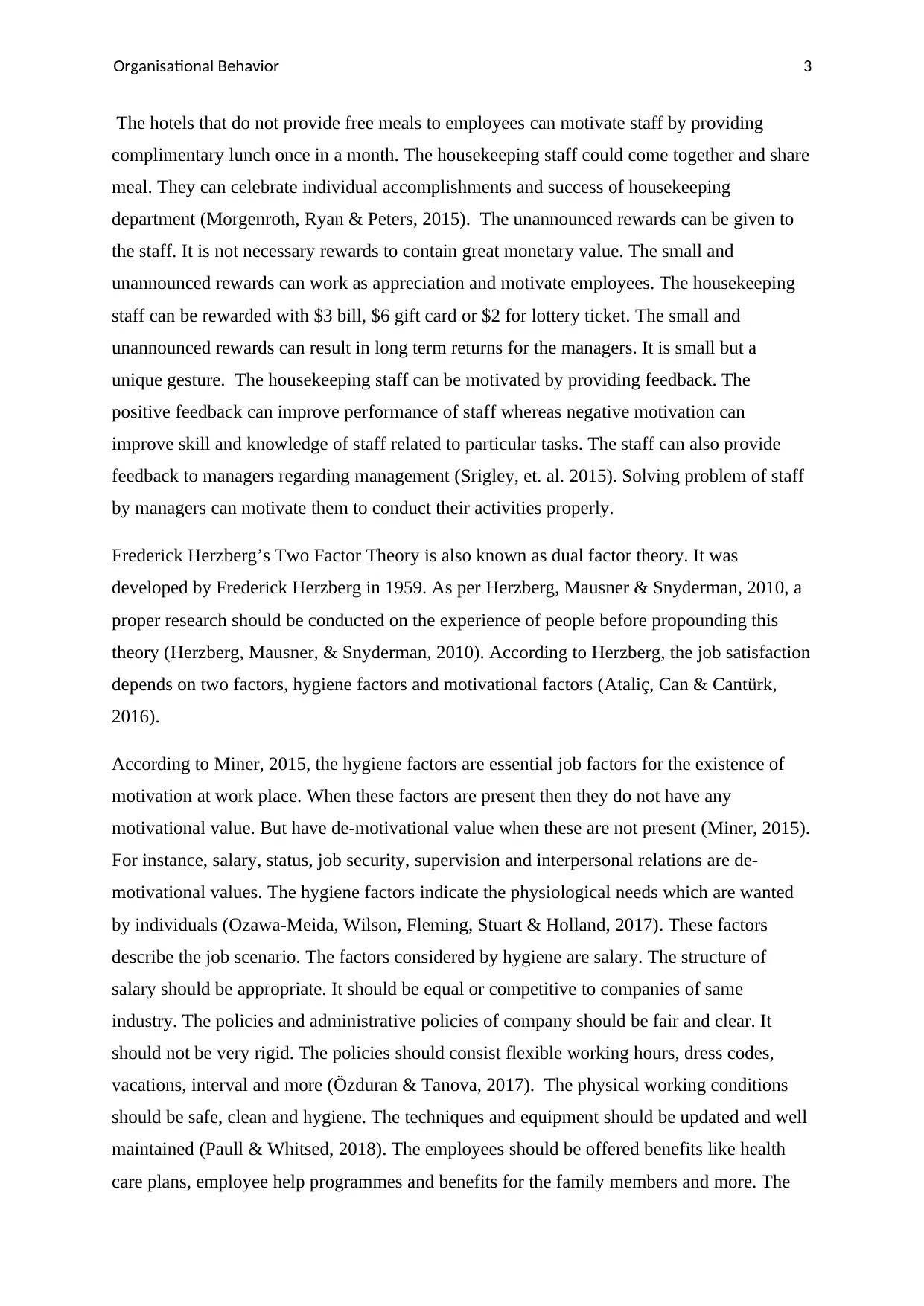
Organisational Behavior 3
The hotels that do not provide free meals to employees can motivate staff by providing
complimentary lunch once in a month. The housekeeping staff could come together and share
meal. They can celebrate individual accomplishments and success of housekeeping
department (Morgenroth, Ryan & Peters, 2015). The unannounced rewards can be given to
the staff. It is not necessary rewards to contain great monetary value. The small and
unannounced rewards can work as appreciation and motivate employees. The housekeeping
staff can be rewarded with $3 bill, $6 gift card or $2 for lottery ticket. The small and
unannounced rewards can result in long term returns for the managers. It is small but a
unique gesture. The housekeeping staff can be motivated by providing feedback. The
positive feedback can improve performance of staff whereas negative motivation can
improve skill and knowledge of staff related to particular tasks. The staff can also provide
feedback to managers regarding management (Srigley, et. al. 2015). Solving problem of staff
by managers can motivate them to conduct their activities properly.
Frederick Herzberg’s Two Factor Theory is also known as dual factor theory. It was
developed by Frederick Herzberg in 1959. As per Herzberg, Mausner & Snyderman, 2010, a
proper research should be conducted on the experience of people before propounding this
theory (Herzberg, Mausner, & Snyderman, 2010). According to Herzberg, the job satisfaction
depends on two factors, hygiene factors and motivational factors (Ataliç, Can & Cantürk,
2016).
According to Miner, 2015, the hygiene factors are essential job factors for the existence of
motivation at work place. When these factors are present then they do not have any
motivational value. But have de-motivational value when these are not present (Miner, 2015).
For instance, salary, status, job security, supervision and interpersonal relations are de-
motivational values. The hygiene factors indicate the physiological needs which are wanted
by individuals (Ozawa-Meida, Wilson, Fleming, Stuart & Holland, 2017). These factors
describe the job scenario. The factors considered by hygiene are salary. The structure of
salary should be appropriate. It should be equal or competitive to companies of same
industry. The policies and administrative policies of company should be fair and clear. It
should not be very rigid. The policies should consist flexible working hours, dress codes,
vacations, interval and more (Özduran & Tanova, 2017). The physical working conditions
should be safe, clean and hygiene. The techniques and equipment should be updated and well
maintained (Paull & Whitsed, 2018). The employees should be offered benefits like health
care plans, employee help programmes and benefits for the family members and more. The
The hotels that do not provide free meals to employees can motivate staff by providing
complimentary lunch once in a month. The housekeeping staff could come together and share
meal. They can celebrate individual accomplishments and success of housekeeping
department (Morgenroth, Ryan & Peters, 2015). The unannounced rewards can be given to
the staff. It is not necessary rewards to contain great monetary value. The small and
unannounced rewards can work as appreciation and motivate employees. The housekeeping
staff can be rewarded with $3 bill, $6 gift card or $2 for lottery ticket. The small and
unannounced rewards can result in long term returns for the managers. It is small but a
unique gesture. The housekeeping staff can be motivated by providing feedback. The
positive feedback can improve performance of staff whereas negative motivation can
improve skill and knowledge of staff related to particular tasks. The staff can also provide
feedback to managers regarding management (Srigley, et. al. 2015). Solving problem of staff
by managers can motivate them to conduct their activities properly.
Frederick Herzberg’s Two Factor Theory is also known as dual factor theory. It was
developed by Frederick Herzberg in 1959. As per Herzberg, Mausner & Snyderman, 2010, a
proper research should be conducted on the experience of people before propounding this
theory (Herzberg, Mausner, & Snyderman, 2010). According to Herzberg, the job satisfaction
depends on two factors, hygiene factors and motivational factors (Ataliç, Can & Cantürk,
2016).
According to Miner, 2015, the hygiene factors are essential job factors for the existence of
motivation at work place. When these factors are present then they do not have any
motivational value. But have de-motivational value when these are not present (Miner, 2015).
For instance, salary, status, job security, supervision and interpersonal relations are de-
motivational values. The hygiene factors indicate the physiological needs which are wanted
by individuals (Ozawa-Meida, Wilson, Fleming, Stuart & Holland, 2017). These factors
describe the job scenario. The factors considered by hygiene are salary. The structure of
salary should be appropriate. It should be equal or competitive to companies of same
industry. The policies and administrative policies of company should be fair and clear. It
should not be very rigid. The policies should consist flexible working hours, dress codes,
vacations, interval and more (Özduran & Tanova, 2017). The physical working conditions
should be safe, clean and hygiene. The techniques and equipment should be updated and well
maintained (Paull & Whitsed, 2018). The employees should be offered benefits like health
care plans, employee help programmes and benefits for the family members and more. The
Paraphrase This Document
Need a fresh take? Get an instant paraphrase of this document with our AI Paraphraser
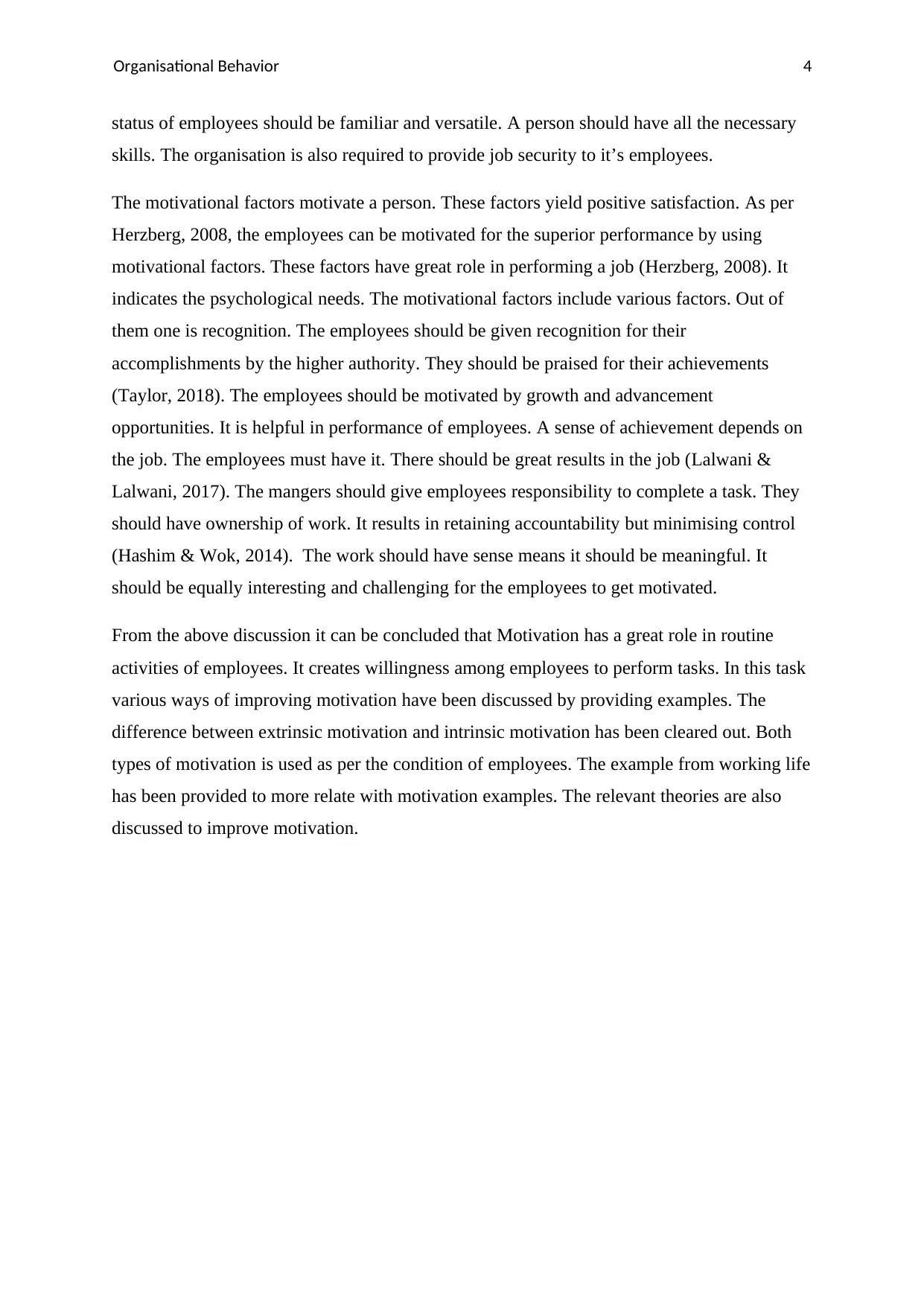
Organisational Behavior 4
status of employees should be familiar and versatile. A person should have all the necessary
skills. The organisation is also required to provide job security to it’s employees.
The motivational factors motivate a person. These factors yield positive satisfaction. As per
Herzberg, 2008, the employees can be motivated for the superior performance by using
motivational factors. These factors have great role in performing a job (Herzberg, 2008). It
indicates the psychological needs. The motivational factors include various factors. Out of
them one is recognition. The employees should be given recognition for their
accomplishments by the higher authority. They should be praised for their achievements
(Taylor, 2018). The employees should be motivated by growth and advancement
opportunities. It is helpful in performance of employees. A sense of achievement depends on
the job. The employees must have it. There should be great results in the job (Lalwani &
Lalwani, 2017). The mangers should give employees responsibility to complete a task. They
should have ownership of work. It results in retaining accountability but minimising control
(Hashim & Wok, 2014). The work should have sense means it should be meaningful. It
should be equally interesting and challenging for the employees to get motivated.
From the above discussion it can be concluded that Motivation has a great role in routine
activities of employees. It creates willingness among employees to perform tasks. In this task
various ways of improving motivation have been discussed by providing examples. The
difference between extrinsic motivation and intrinsic motivation has been cleared out. Both
types of motivation is used as per the condition of employees. The example from working life
has been provided to more relate with motivation examples. The relevant theories are also
discussed to improve motivation.
status of employees should be familiar and versatile. A person should have all the necessary
skills. The organisation is also required to provide job security to it’s employees.
The motivational factors motivate a person. These factors yield positive satisfaction. As per
Herzberg, 2008, the employees can be motivated for the superior performance by using
motivational factors. These factors have great role in performing a job (Herzberg, 2008). It
indicates the psychological needs. The motivational factors include various factors. Out of
them one is recognition. The employees should be given recognition for their
accomplishments by the higher authority. They should be praised for their achievements
(Taylor, 2018). The employees should be motivated by growth and advancement
opportunities. It is helpful in performance of employees. A sense of achievement depends on
the job. The employees must have it. There should be great results in the job (Lalwani &
Lalwani, 2017). The mangers should give employees responsibility to complete a task. They
should have ownership of work. It results in retaining accountability but minimising control
(Hashim & Wok, 2014). The work should have sense means it should be meaningful. It
should be equally interesting and challenging for the employees to get motivated.
From the above discussion it can be concluded that Motivation has a great role in routine
activities of employees. It creates willingness among employees to perform tasks. In this task
various ways of improving motivation have been discussed by providing examples. The
difference between extrinsic motivation and intrinsic motivation has been cleared out. Both
types of motivation is used as per the condition of employees. The example from working life
has been provided to more relate with motivation examples. The relevant theories are also
discussed to improve motivation.
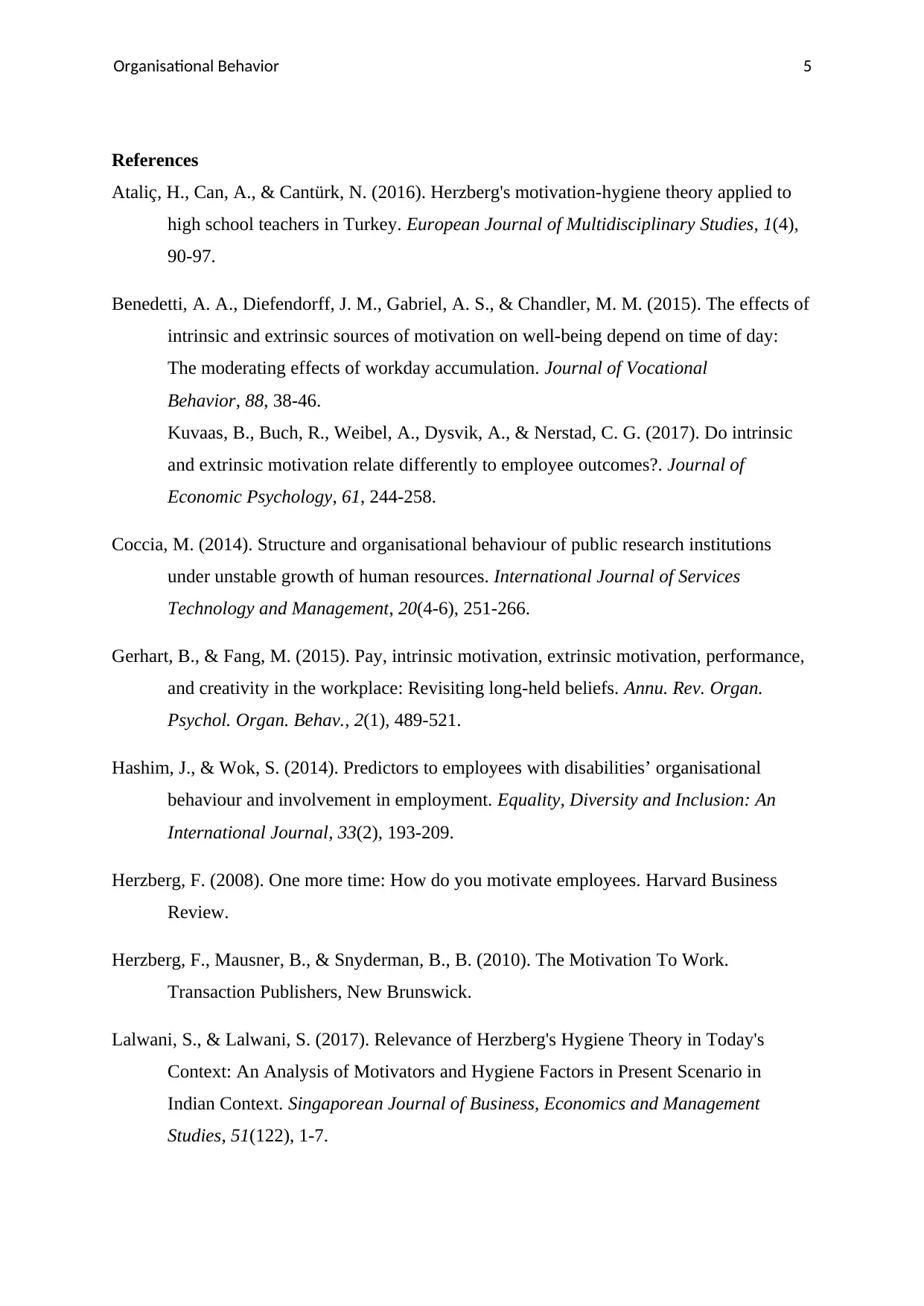
Organisational Behavior 5
References
Ataliç, H., Can, A., & Cantürk, N. (2016). Herzberg's motivation-hygiene theory applied to
high school teachers in Turkey. European Journal of Multidisciplinary Studies, 1(4),
90-97.
Benedetti, A. A., Diefendorff, J. M., Gabriel, A. S., & Chandler, M. M. (2015). The effects of
intrinsic and extrinsic sources of motivation on well-being depend on time of day:
The moderating effects of workday accumulation. Journal of Vocational
Behavior, 88, 38-46.
Kuvaas, B., Buch, R., Weibel, A., Dysvik, A., & Nerstad, C. G. (2017). Do intrinsic
and extrinsic motivation relate differently to employee outcomes?. Journal of
Economic Psychology, 61, 244-258.
Coccia, M. (2014). Structure and organisational behaviour of public research institutions
under unstable growth of human resources. International Journal of Services
Technology and Management, 20(4-6), 251-266.
Gerhart, B., & Fang, M. (2015). Pay, intrinsic motivation, extrinsic motivation, performance,
and creativity in the workplace: Revisiting long-held beliefs. Annu. Rev. Organ.
Psychol. Organ. Behav., 2(1), 489-521.
Hashim, J., & Wok, S. (2014). Predictors to employees with disabilities’ organisational
behaviour and involvement in employment. Equality, Diversity and Inclusion: An
International Journal, 33(2), 193-209.
Herzberg, F. (2008). One more time: How do you motivate employees. Harvard Business
Review.
Herzberg, F., Mausner, B., & Snyderman, B., B. (2010). The Motivation To Work.
Transaction Publishers, New Brunswick.
Lalwani, S., & Lalwani, S. (2017). Relevance of Herzberg's Hygiene Theory in Today's
Context: An Analysis of Motivators and Hygiene Factors in Present Scenario in
Indian Context. Singaporean Journal of Business, Economics and Management
Studies, 51(122), 1-7.
References
Ataliç, H., Can, A., & Cantürk, N. (2016). Herzberg's motivation-hygiene theory applied to
high school teachers in Turkey. European Journal of Multidisciplinary Studies, 1(4),
90-97.
Benedetti, A. A., Diefendorff, J. M., Gabriel, A. S., & Chandler, M. M. (2015). The effects of
intrinsic and extrinsic sources of motivation on well-being depend on time of day:
The moderating effects of workday accumulation. Journal of Vocational
Behavior, 88, 38-46.
Kuvaas, B., Buch, R., Weibel, A., Dysvik, A., & Nerstad, C. G. (2017). Do intrinsic
and extrinsic motivation relate differently to employee outcomes?. Journal of
Economic Psychology, 61, 244-258.
Coccia, M. (2014). Structure and organisational behaviour of public research institutions
under unstable growth of human resources. International Journal of Services
Technology and Management, 20(4-6), 251-266.
Gerhart, B., & Fang, M. (2015). Pay, intrinsic motivation, extrinsic motivation, performance,
and creativity in the workplace: Revisiting long-held beliefs. Annu. Rev. Organ.
Psychol. Organ. Behav., 2(1), 489-521.
Hashim, J., & Wok, S. (2014). Predictors to employees with disabilities’ organisational
behaviour and involvement in employment. Equality, Diversity and Inclusion: An
International Journal, 33(2), 193-209.
Herzberg, F. (2008). One more time: How do you motivate employees. Harvard Business
Review.
Herzberg, F., Mausner, B., & Snyderman, B., B. (2010). The Motivation To Work.
Transaction Publishers, New Brunswick.
Lalwani, S., & Lalwani, S. (2017). Relevance of Herzberg's Hygiene Theory in Today's
Context: An Analysis of Motivators and Hygiene Factors in Present Scenario in
Indian Context. Singaporean Journal of Business, Economics and Management
Studies, 51(122), 1-7.
⊘ This is a preview!⊘
Do you want full access?
Subscribe today to unlock all pages.

Trusted by 1+ million students worldwide
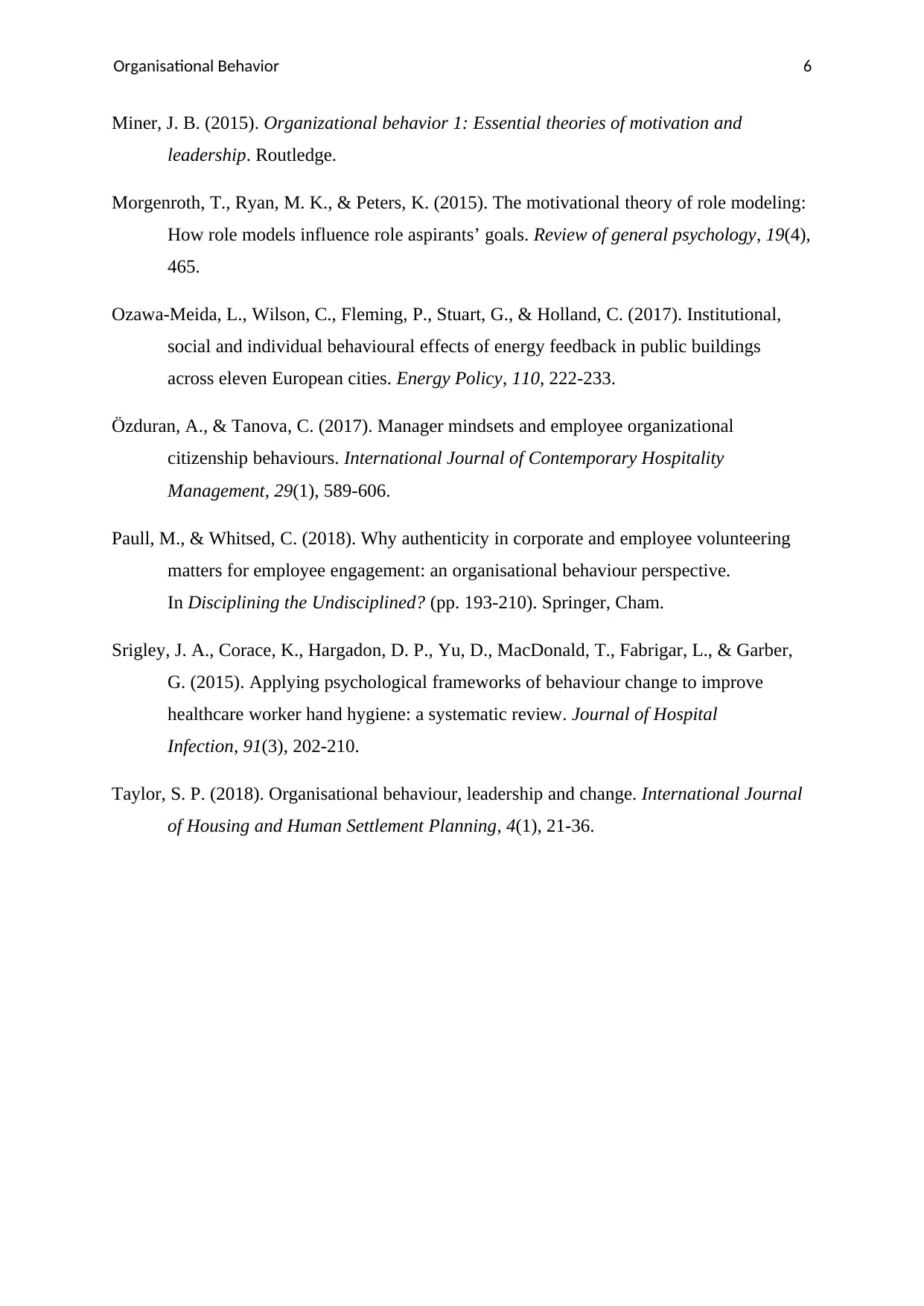
Organisational Behavior 6
Miner, J. B. (2015). Organizational behavior 1: Essential theories of motivation and
leadership. Routledge.
Morgenroth, T., Ryan, M. K., & Peters, K. (2015). The motivational theory of role modeling:
How role models influence role aspirants’ goals. Review of general psychology, 19(4),
465.
Ozawa-Meida, L., Wilson, C., Fleming, P., Stuart, G., & Holland, C. (2017). Institutional,
social and individual behavioural effects of energy feedback in public buildings
across eleven European cities. Energy Policy, 110, 222-233.
Özduran, A., & Tanova, C. (2017). Manager mindsets and employee organizational
citizenship behaviours. International Journal of Contemporary Hospitality
Management, 29(1), 589-606.
Paull, M., & Whitsed, C. (2018). Why authenticity in corporate and employee volunteering
matters for employee engagement: an organisational behaviour perspective.
In Disciplining the Undisciplined? (pp. 193-210). Springer, Cham.
Srigley, J. A., Corace, K., Hargadon, D. P., Yu, D., MacDonald, T., Fabrigar, L., & Garber,
G. (2015). Applying psychological frameworks of behaviour change to improve
healthcare worker hand hygiene: a systematic review. Journal of Hospital
Infection, 91(3), 202-210.
Taylor, S. P. (2018). Organisational behaviour, leadership and change. International Journal
of Housing and Human Settlement Planning, 4(1), 21-36.
Miner, J. B. (2015). Organizational behavior 1: Essential theories of motivation and
leadership. Routledge.
Morgenroth, T., Ryan, M. K., & Peters, K. (2015). The motivational theory of role modeling:
How role models influence role aspirants’ goals. Review of general psychology, 19(4),
465.
Ozawa-Meida, L., Wilson, C., Fleming, P., Stuart, G., & Holland, C. (2017). Institutional,
social and individual behavioural effects of energy feedback in public buildings
across eleven European cities. Energy Policy, 110, 222-233.
Özduran, A., & Tanova, C. (2017). Manager mindsets and employee organizational
citizenship behaviours. International Journal of Contemporary Hospitality
Management, 29(1), 589-606.
Paull, M., & Whitsed, C. (2018). Why authenticity in corporate and employee volunteering
matters for employee engagement: an organisational behaviour perspective.
In Disciplining the Undisciplined? (pp. 193-210). Springer, Cham.
Srigley, J. A., Corace, K., Hargadon, D. P., Yu, D., MacDonald, T., Fabrigar, L., & Garber,
G. (2015). Applying psychological frameworks of behaviour change to improve
healthcare worker hand hygiene: a systematic review. Journal of Hospital
Infection, 91(3), 202-210.
Taylor, S. P. (2018). Organisational behaviour, leadership and change. International Journal
of Housing and Human Settlement Planning, 4(1), 21-36.
1 out of 7
Related Documents
Your All-in-One AI-Powered Toolkit for Academic Success.
+13062052269
info@desklib.com
Available 24*7 on WhatsApp / Email
![[object Object]](/_next/static/media/star-bottom.7253800d.svg)
Unlock your academic potential
Copyright © 2020–2025 A2Z Services. All Rights Reserved. Developed and managed by ZUCOL.




